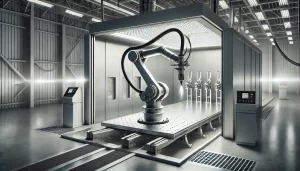When operating a sandblasting booth, it’s essential to keep safety top of mind. Not only does it protect your workers, but it also ensures that your business stays compliant and productive. Understanding the OSHA (Occupational Safety and Health Administration) regulations for sandblasting booths can help you create a safer, more efficient workplace, minimizing risks and potential fines. Let’s explore exactly what these regulations entail and how you can easily incorporate them into your daily operations.
Why OSHA Regulations Matter
Safety regulations might seem overwhelming at first, but they exist for good reasons. Sandblasting, also known as abrasive blasting, involves using high-pressure equipment to clean, smooth, or shape various surfaces. This powerful process exposes workers to significant risks such as inhaling harmful dust, exposure to flying debris, and hearing damage from loud equipment.
By following OSHA’s guidelines, you not only protect your team but also ensure smoother operations, fewer interruptions due to accidents, and peace of mind knowing your workplace is safe.
Essential OSHA Requirements for Sandblasting Booths
When you look into OSHA’s regulations, there are several critical areas to focus on. Let’s simplify these key requirements:
Proper Ventilation and Dust Collection
A fundamental OSHA regulation is ensuring your sandblasting booth is equipped with proper ventilation and dust collection systems. Abrasive blasting generates substantial amounts of hazardous dust. To prevent worker exposure, OSHA requires efficient dust collection systems that effectively capture and filter dust, maintaining air quality within acceptable standards.
A well-designed ventilation system draws dust away from operators, ensuring clean, breathable air. Regular inspections and maintenance of these systems are mandatory, keeping filters clean and ensuring fans operate correctly. This not only maintains compliance but also prolongs equipment life and improves overall productivity.
Personal Protective Equipment (PPE)
Providing adequate personal protective equipment is another core OSHA regulation. Workers involved in sandblasting must be equipped with specialized respiratory protection, helmets with impact-resistant face shields, gloves, protective clothing, and hearing protection.
Respirators used in sandblasting operations should meet OSHA’s standards for particulate filtration and must be regularly tested and maintained. Training your staff on correctly using PPE not only ensures compliance but also drastically reduces workplace injuries.
Safe Equipment and Procedures
OSHA emphasizes regular inspection and maintenance of sandblasting equipment. All blasting machines and hoses must be routinely checked for wear, leaks, and other hazards. Establishing clear procedures and training staff thoroughly on safe operations, proper handling, and emergency response significantly enhances workplace safety.
Workers should be trained to recognize potential hazards, understand equipment functionality, and respond swiftly in case of emergencies. Documentation of these trainings and maintenance activities helps demonstrate compliance during inspections.
Proper Booth Design and Construction
The physical structure of your sandblasting booth must also comply with OSHA regulations. Booths must be robustly constructed with durable materials to withstand high-pressure abrasive operations. Interior surfaces should be smooth, non-reactive, and easy to clean, preventing the accumulation of hazardous dust.
Lighting inside the booth must be adequate, ensuring clear visibility without glare or shadows, reducing the risk of accidents. OSHA requires emergency shut-off controls to be easily accessible, clearly labeled, and regularly tested to ensure functionality.
Understanding Exposure Limits
OSHA sets permissible exposure limits (PELs) to protect workers from harmful airborne contaminants commonly found in sandblasting dust, like silica. Monitoring air quality in and around your sandblasting booth is essential. Conduct regular air quality tests to ensure contaminant levels remain below OSHA’s specified limits.
If monitoring reveals airborne contaminants exceeding OSHA’s limits, you must promptly take corrective action, such as enhancing ventilation or upgrading respiratory protection. Keeping detailed records of these tests is critical for demonstrating compliance and protecting employee health.
Ensuring Compliance Through Training and Documentation
Maintaining compliance with OSHA regulations doesn’t stop with equipment or facility upgrades. Comprehensive employee training and thorough documentation are equally important. OSHA inspectors often request training records, equipment maintenance logs, and air quality monitoring reports during inspections.
Regular safety training sessions should address proper equipment use, recognizing and mitigating hazards, emergency response procedures, and correct PPE use. Clear, concise documentation demonstrates your business’s ongoing commitment to safety and compliance.
Benefits Beyond Compliance
Embracing OSHA regulations does more than merely keep your business compliant—it creates a safer, healthier work environment that boosts employee morale, productivity, and overall business reputation. Companies known for prioritizing safety attract more skilled workers and build stronger relationships with customers and regulatory agencies.
Furthermore, compliance reduces costly downtime due to accidents or regulatory fines. Investing proactively in safety equipment, proper booth construction, regular training, and meticulous documentation translates into long-term financial savings and operational efficiency.
Taking the Next Steps
Implementing OSHA regulations into your sandblasting operations might initially seem daunting, but it’s easier than it appears with the right strategy. Start by auditing your existing processes and equipment to identify any compliance gaps. Engage safety professionals or OSHA-certified experts to help evaluate your facilities and provide specific recommendations tailored to your operations.
Equip your staff with clear, practical training, invest in quality protective gear, and maintain diligent documentation. Soon, you’ll find these compliance measures seamlessly integrated into your daily routines, fostering a workplace culture of safety and responsibility.
Specialized Sandblasting Booth Services
We specialize in providing top-quality sandblasting booths and custom finishing solutions tailored to meet the unique needs of various industries. Our expert team designs and manufactures state-of-the-art sandblasting booths that ensure safety, efficiency, and superior performance. From automotive and aerospace to marine and industrial applications, our booths are engineered to handle even the most demanding surface preparation tasks. We offer comprehensive services, including booth installation, maintenance, upgrades, and technical support.




